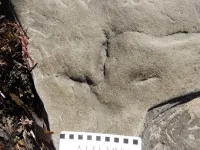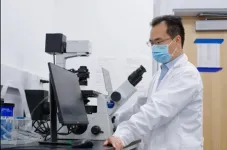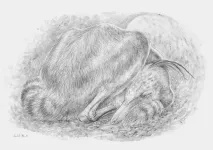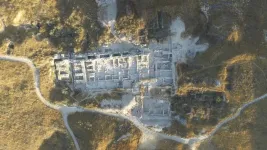(Press-News.org) Macrophages, a type of white blood cell that can destroy invading pathogens, have an innate ability to infiltrate tumor cells, making them a potentially important tool in treatments that use transplanted cells to fight disease, known as cell therapy. In the lab, macrophages show a lot of promise in treating cancer but so far, clinical trials have been a disappointment and biologists are trying to figure out why.
But what if it’s not a biological problem?
In a recent paper, researchers from the Harvard John A. Paulson School of Engineering and Applied Sciences (SEAS) approached the failure of macrophages in clinical trials from an engineering perspective.
The research team, led by Samir Mitragotri, the Hiller Professor of Bioengineering and Hansjorg Wyss Professor of Biologically Inspired Engineering at SEAS, looked at the physical barriers that might be preventing macrophages from reaching their target in the first place.
By combining microscopy with machine learning, the team found that a specific phenotype of macrophage was better at traveling to the tumor than others — and it’s not the one that researchers commonly use in the clinic for cancer therapies.
The research was published Applied Physics Reviews.
“Our engineering approach led us to question whether the poor therapeutic outcome of macrophages in cell therapies can in part originate from their inability to get into the tumor in the first place,” said Mitragotri. “And indeed, our results show that different phenotypes exhibit different penetration into the tumor. This provides an interesting physics-based hypothesis for the poor clinical outcome of previously reported macrophage therapies and provides a counter- and complimentary hypothesis to the classical biology-based paradigm.”
There are multiple types of macrophages, simplified as M0, M1, and M2. Of the three, M1 macrophages have the best tumor-fighting capacities and therefore have been used the most for cell therapies. But they have yielded disappointing results in clinical trials.
Mitragotri and his team looked at how each of the three different phenotypes could move through a complex hydrogel and into a tumor in a petri dish.
“We basically wanted to measure how well the transport mechanics and GPS of these different macrophages worked in a complex environment,” said Kolade Adebowale, a postdoctoral fellow at SEAS and first author of the paper. “We found that the M1 phenotype, anti-tumor microphage, seem to have trouble finding their targets, almost like their GPS wasn’t working. But the M0 phenotype seemed to have a really good map.”
The big question is why.
It’s well known that macrophages exist in various shapes and some phenotypes are really good at changing their shape. Adebowale and the team found a correlation between shape-shifting abilities and transport efficiency — meaning the better the macrophage was at shape shifting, the better able they were to get to the tumor.
And, as it turned out, M1 macrophages are the worst of the three when it comes to shapeshifting.
“Our study demonstrates that the reduced transport of M1 macrophages compared to M0 macrophages is correlated with their reduced ability to undergo shape transformations,” said Adebowale. “We hope that these findings shed new light on the biophysics of macrophage migration and delivery of macrophage cell therapies.”
“There is tremendous potential in utilizing macrophages to mediate anti-tumor immune responses in human tumors and clinical trials are ongoing to treat patients with macrophages,” said Jennifer Guerriero, Assistant Professor at Harvard Medical School, lead investigator of Brigham and Women’s Hospital Breast Oncology Program and co-author of the study. “We learned in this study that, surprisingly, macrophages that resemble an M0 phenotype were most efficient at getting to their target. These data will have an immediate impact on clinical trials are likely to transform the next generation of macrophage-mediated therapies.”
The research was supported by the National Science Foundation under Award No. 2138064.
END
Shape-shifting immune cells offer new insights into cancer immunotherapy
Research sheds light on long-standing question
2023-11-15
ELSE PRESS RELEASES FROM THIS DATE:
All aquatic species in river mouths are contaminated by microplastics
2023-11-15
All aquatic species in the river mouths flowing into the Mediterranean Sea and Atlantic Ocean are contaminated with microplastics, with molluscs being the most affected due to their ability to filter water. Rivers are one of the main sources of pollution by microplastics (5 to 0.0001 mm in size) and nanoplastics (smaller than 0.0001mm) in the oceans. Estuaries, as transition zones between rivers and the sea, are major hotspots for the accumulation of these particles, which are retained in sediments. They pose a threat to aquatic ecosystems given their ability to capture harmful chemicals from the surrounding environment, ...
Smaller hippocampus linked to cognitive decline
2023-11-15
MINNEAPOLIS – With the rise of new drugs that can target the amyloid-beta plaques in the brain that are an early sign of Alzheimer’s disease, new ways are needed to determine whether memory loss and thinking problems are due to Alzheimer’s disease or another neurodegenerative disorder. A new study published in the November 15, 2023, online issue of Neurology®, the medical journal of the American Academy of Neurology, shows that shrinkage in the hippocampus area of the brain is associated with cognitive decline, even in people who don’t have amyloid plaques in the brain. The hippocampus plays a role in memory.
“These results suggest ...
ECOG-ACRIN and PrECOG announce multiple presentations at the American Society of Hematology (ASH) 2023 annual meeting
2023-11-15
Researchers with the ECOG-ACRIN Cancer Research Group (ECOG-ACRIN) and PrECOG, LLC, will present six oral and three poster presentations at the 65th American Society of Hematology (ASH) Meeting & Exposition, occurring in San Diego, California and virtually December 9-12, 2023. The presentations focus on treatments for acute leukemias and lymphomas.
Among the data are the promising results of the phase 2 PrE0405 trial, which evaluated bendamustine, rituximab, and venetoclax for the initial treatment of mantle cell lymphoma in older patients. Other ...
Use it or lose it: New robotic system assesses mobility after stroke
2023-11-15
Embargoed: Not for Release Until 2:00 pm U.S. Eastern Time Wednesday, 15 November 2023
Stroke is a leading cause of long-term disability worldwide. Each year more than 15 million people worldwide have strokes, and three-quarters of stroke survivors will experience impairment, weakness and paralysis in their arms and hands.
Many stroke survivors rely on their stronger arm to complete daily tasks, from carrying groceries to combing their hair, even when the weaker arm has the potential to improve. Breaking this habit, known as “arm nonuse” or “learned nonuse,” can improve strength and prevent injury.
But, determining how much ...
Birds set foot near South Pole in Early Cretaceous, Australian tracks show
2023-11-15
The discovery of 27 avian footprints on the southern Australia coast — dating back to the Early Cretaceous when Australia was still connected to Antarctica — opens another window onto early avian evolution and possible migratory behavior.
PLOS ONE published the discovery of some of the oldest, positively identified bird tracks in the Southern Hemisphere, dated to between 120 million and 128 million years ago.
“Most of the bird tracks and body fossils dating as far back as the Early Cretaceous are from the Northern Hemisphere, particularly from Asia,” says Anthony Martin, first ...
University of Kentucky bioengineer designs tools to improve treatment for head and neck cancer
2023-11-15
LEXINGTON, Ky. (Nov. 15, 2023) — One University of Kentucky researcher is working to develop new techniques for radiation treatment to improve survival rates of patients with a specific type of cancer.
Caigang Zhu, Ph.D., is an assistant professor in the Department of Biomedical Engineering in the UK Stanley and Karen Pigman College of Engineering. He is also a member of the Molecular and Cellular Oncology Research Program at the UK Markey Cancer Center.
The National Institute of Dental and Craniofacial Research of ...
New plant hardiness map, used by gardeners nationwide and based on OSU climate data, unveiled
2023-11-15
CORVALLIS, Ore. – The U.S. Department of Agriculture today released its new Plant Hardiness Zone Map, the national standard by which gardeners can determine which plants are most likely to survive the coldest winter temperatures at a certain location.
The USDA describes the latest map, jointly developed by Oregon State University’s PRISM Climate Group and the USDA’s Agricultural Research Service, as the most accurate and detailed it has ever released.
PRISM, part of the OSU College of Engineering, stands for Parameter-elevation Regressions on Independent Slopes Model. The previous version of the plant hardiness map, also based ...
An engineered protein enhances memory
2023-11-15
Neuroscientists at the Faculty of Medicine and Surgery of the Catholic University, Rome, and the Fondazione Policlinico Universitario Agostino Gemelli IRCCS have genetically modified a molecule, the protein LIMK1, which is normally active in the brain, with a key role in memory. They added a "molecular switch" that is activated by administering a drug, rapamycin, known for its several anti-aging effects on the brain.
This is the result of a study published in the journal Science Advances, which involves the Catholic ...
New near-complete skeleton of a bird-like dinosaur is found in a position which suggests it slept like modern birds
2023-11-15
New near-complete skeleton of a bird-like dinosaur is found in a position which suggests it slept like modern birds
###
Article URL: https://journals.plos.org/plosone/article?id=10.1371/journal.pone.0293801
Article Title: A new alvarezsaurid dinosaur (Theropoda, Alvarezsauria) from the Upper Cretaceous Baruungoyot Formation of Mongolia provides insights for bird-like sleeping behavior in non-avian dinosaurs
Author Countries: Japan, Mongolia
Funding: Funding for this project was granted by Research Fellowships from the Japan Society for the Promotion of Science (JSPS 21J12938) (to KK) and Ami Koshimizu (Endless Glory Office Restart Co., Ltd.) (to KK). The funders had ...
Radiocarbon dating meets Egyptology and Biblical accounts in the city of Gezer
2023-11-15
New dates provide detailed insights into the timing of events in the ancient city of Gezer, according to a study published November 15, 2023 in the open-access journal PLOS ONE by Lyndelle Webster of the Austrian Academy of Sciences and colleagues.
Gezer is an ancient southern Levantine city, well known from Egyptian, Assyrian, and Biblical texts and associated with stories of power struggles and significant historical figures. It is also a rich archaeological site with abundant Bronze Age and Iron Age remains and with great potential for research into the daily lives of its denizens. Recent excavations at the site have uncovered a continuous stratigraphic ...
LAST 30 PRESS RELEASES:
Numbers in our sights affect how we perceive space
SIMJ announces global collaborative book project in commemoration of its 75th anniversary
Air pollution exposure and birth weight
Obstructive sleep apnea risk and mental health conditions among older adults
How talking slows eye movements behind the wheel
The Ceramic Society of Japan’s Oxoate Ceramics Research Association launches new international book project
Heart-brain connection: international study reveals the role of the vagus nerve in keeping the heart young
Researchers identify Rb1 as a predictive biomarker for a new therapeutic strategy in some breast cancers
Survey reveals ethical gaps slowing AI adoption in pediatric surgery
Stimulant ADHD medications work differently than thought
AI overestimates how smart people are, according to HSE economists
HSE researchers create genome-wide map of quadruplexes
Scientists boost cell "powerhouses" to burn more calories
Automatic label checking: The missing step in making reliable medical AI
Low daily alcohol intake linked to 50% heightened mouth cancer risk in India
American Meteorological Society announces Rick Spinrad as 2026 President-Elect
Biomass-based carbon capture spotlighted in newly released global climate webinar recording
Illuminating invisible nano pollutants: advanced bioimaging tracks the full journey of emerging nanoscale contaminants in living systems
How does age affect recovery from spinal cord injury?
Novel AI tool offers prognosis for patients with head and neck cancer
Fathers’ microplastic exposure tied to their children’s metabolic problems
Research validates laboratory model for studying high-grade serous ovarian cancer
SIR 2026 delivers transformative breakthroughs in minimally invasive medicine to improve patient care
Stem Cell Reports most downloaded papers of 2025 highlight the breadth and impact of stem cell research
Oxford-led study estimates NHS spends around 3% of its primary and secondary care budget on the health impacts of heat and cold in England
A researcher’s long quest leads to a smart composite breakthrough
Urban wild bees act as “microbial sensors” of city health.
New study finds where you live affects recovery after a hip fracture
Forecasting the impact of fully automated vehicle adoption on US road traffic injuries
Alcohol-related hospitalizations from 2016 to 2022
[Press-News.org] Shape-shifting immune cells offer new insights into cancer immunotherapyResearch sheds light on long-standing question






